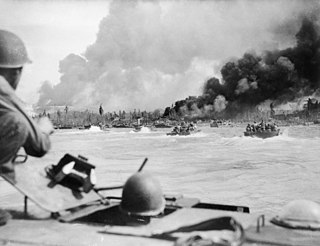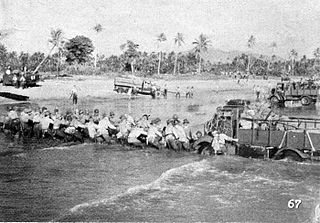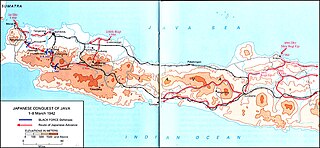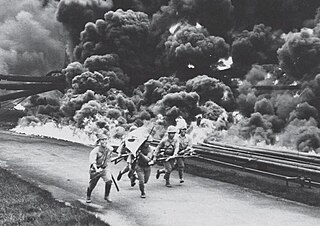
The Southern Expeditionary Army Group was a general army of the Imperial Japanese Army during World War II. It was responsible for all military operations in South East Asian and South West Pacific campaigns of World War II. Its military symbol was NA.

The Royal Netherlands East Indies Army was the military force maintained by the Kingdom of the Netherlands in its colony of the Dutch East Indies, in areas that are now part of Indonesia. The KNIL's air arm was the Royal Netherlands East Indies Army Air Force. Elements of the Royal Netherlands Navy and Government Navy were also stationed in the Netherlands East Indies.
The Battle of Ambon occurred on Ambon Island in the Dutch East Indies, as part of the Japanese offensive on the Dutch colony during World War II. In the face of a combined defense by Dutch and Australian troops, Japanese forces conquered the island and its strategic airfield in several days. In the aftermath of the fighting, a major massacre of many Dutch and Australian prisoners of war by the Imperial Japanese Army (IJA) followed. Following the war, many of the IJA personnel were tried for war crimes.

The Battle of Balikpapan was the concluding stage of Operation Oboe, the campaign to liberate Japanese-held British and Dutch Borneo. The landings took place on 1 July 1945. The Australian 7th Division, composed of the 18th, 21st and 25th Infantry Brigades, with a small number of Netherlands East Indies KNIL troops, made an amphibious landing, codenamed Operation Oboe Two, a few miles north of Balikpapan. The Allied invasion fleet consisted of around 100 ships. The landing had been preceded by heavy bombing and shelling by Australian and US air and naval forces. The Allied force totalled 33,000 personnel and was commanded by Major General Edward Milford, while the Japanese force, commanded by Rear Admiral Michiaki Kamada, numbered between 8,400 and 10,000, of which between 3,100 and 3,900 were combatants. After the initial landing, the Allies secured the town and its port, and then advanced along the coast and into the hinterland, capturing the two Japanese airfields. Major combat operations concluded around 21 July, but were followed by mopping-up operations, which lasted until the end of the war in mid-August. Australian troops remained in the area until early 1946.
The Battle of Tarakan took place on 11–12 January 1942, a day after the Empire of Japan declared war on the Kingdom of the Netherlands. Although Tarakan was only a small marshy island off northeastern Borneo in the Netherlands East Indies, its 700 oil wells, refineries, and airfield made it a crucial objective for Japan in the Pacific War.

The Dutch East Indies campaign of 1941–1942 was the conquest of the Dutch East Indies by forces of the Empire of Japan in the early days of the Pacific campaign of World War II. Allied forces attempted unsuccessfully to defend the islands. The East Indies were targeted by the Japanese for their rich oil resources which would become a vital asset during the war. The campaign and subsequent three-and-a-half-year Japanese occupation was also a major factor in the end of Dutch colonial rule in the region.

The Battle of Java was a battle of the Pacific theatre of World War II. It occurred on the island of Java from 28 February – 12 March 1942. It involved forces from the Empire of Japan, which invaded on 28 February 1942, and Allied personnel. Allied commanders signed a formal surrender at Japanese headquarters at Bandung on 12 March.

The First Battle of Balikpapan took place on 23–25 January 1942, off the major oil-producing town and port of Balikpapan, on Borneo, in the Netherlands East Indies. After capturing mostly-destroyed oilfields at Tarakan, Japanese forces send an ultimatum to the Dutch that they would be executed if they destroyed the oilfields there, to no avail.

The Battle of Palembang was a battle of the Pacific theatre of World War II. It occurred near Palembang, on Sumatra, on 13–15 February 1942. The Royal Dutch Shell oil refineries at nearby Plaju were the major objectives for the Empire of Japan in the Pacific War, because of an oil embargo imposed on Japan by the United States, the Netherlands, and the United Kingdom after the Japanese invaded China. With the area's abundant fuel supply and airfield, Palembang offered significant potential as a military base to both the Allies and the Japanese.

The Battle of Manado took place as part of the Japanese offensive to capture the Dutch East Indies. It occurred at Manado on the Minahasa Peninsula on the northern part of Celebes Island, from 11–12 January 1942. The battle was noted as the first time in Japanese history that the country had deployed paratroopers in a military operation.

ToshinariShōji was a major general in the Imperial Japanese Army during the Pacific campaign in World War II.

The Invasion of Sumatra was the assault by Imperial Japanese forces on the Dutch East Indies that took place from 14 February to 28 March 1942. The invasion was part of the Pacific War in South-East Asia during World War II and led to the capture of the island. The invasion of Sumatra was planned to occur prior to the invasion of Java to destroy the west flank of the allies and to give access to Java.

Suryadarma Air Force Base is one of the Indonesian Air Force bases on Java. Formerly known as Kalijati Airfield, it is located in the village of Kalijati, in the kabupaten of Subang in West Java.

Albert Eduard Stoové was a sergeant in the Royal Netherlands East Indies Army Air Force at the start of World War II. For several actions with the 2-VLG-V squadron under command of Captain Jacob Pieter van Helsdingen he received the Vliegerkruis on 24 February 1942.

The Bougainville counterattack, also known as the Second Battle of Torokina, was an unsuccessful Japanese offensive against the Allied base at Cape Torokina on Bougainville Island during the Pacific Theater of World War II. The Japanese attack began on 8 March 1944 after months of preparation and was repulsed by United States Army forces in fighting which lasted until 25 March. The attack was hampered by inaccurate intelligence and poor planning and was pushed back by the well-prepared Allied defenders, who greatly outnumbered the Japanese force. The Japanese suffered severe casualties, while Allied losses were light.

The Battle of Tjiater Pass occurred between 5 and 7 March 1942 during the Dutch East Indies campaign between invading Japanese forces and the Dutch colonial forces, supported by warplanes from the Royal Air Force. It was fought over control of the Tjiater Pass, as part of an attempted defense of the city of Bandung.

The Battle of Leuwiliang was a battle during the Dutch East Indies campaign of the Pacific War that took place between 3 and 5 March 1942. Australian forces, supported by American artillery batteries and British tanks, launched a holding action starting at Leuwiliang, West Java, to cover the retreat of allied Dutch forces in the face of the Japanese invasion of Java.

The Battle of Banjarmasin took place as part of the Japanese offensive to capture the Dutch East Indies. The Japanese conducted a pincer attack from sea and land to capture a strategic airfield in Banjarmasin in preparation for the capture of Java Island.
The Battle of Kendari took place on 24 January 1942 as part of the Japanese offensive in the Dutch East Indies. The airfield Kendari II at Kendari became an essential target for Japanese forces for its strategic location and infrastructure quality. Encountering little to no resistance, Japanese troops managed to capture the airfield in one day, as the Dutch defenders were already in retreat inland.

Major General Jacob Jan Pesman was a Dutch military officer during the Second World War. He was a commander in the KNIL colonial forces of the Dutch East Indies, and was the commander of one of its units during the Japanese invasion of Java.



















